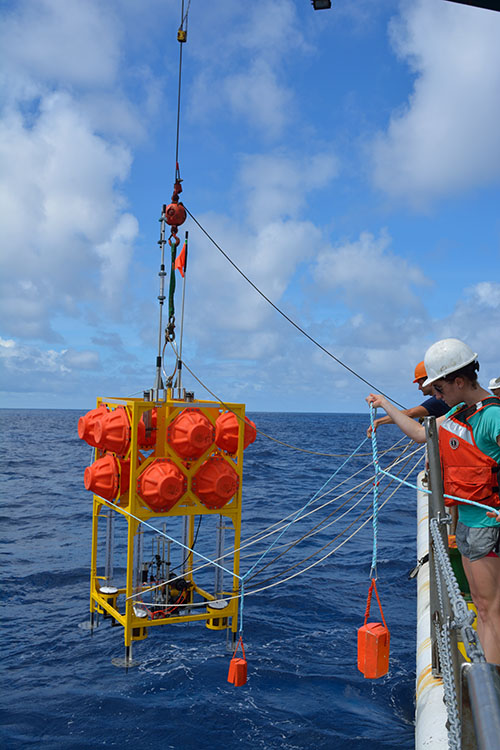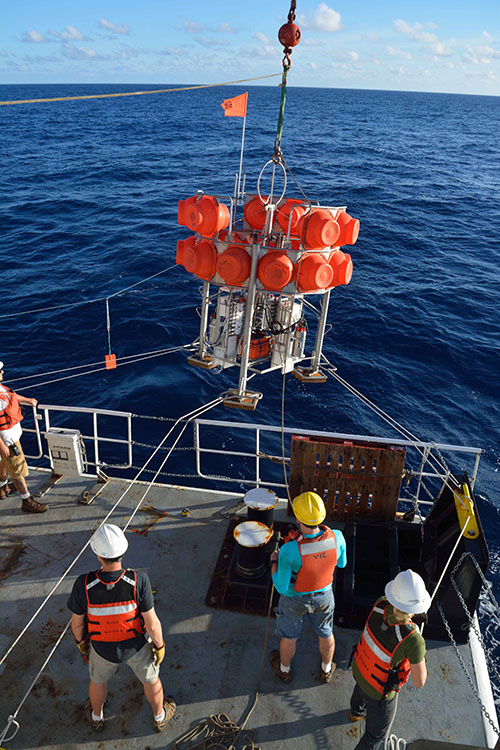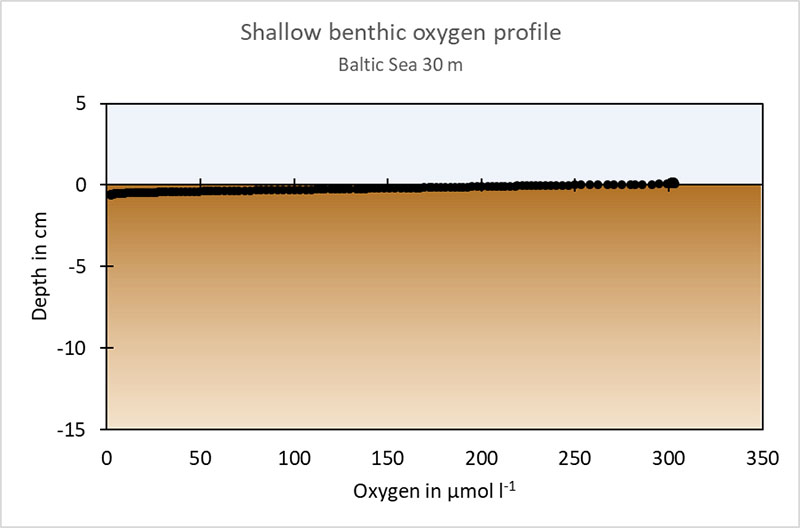
By Annabell Moser, Marine Biologist, The Lyell Centre, Heriot-Watt University, Edinburgh
June 13, 2018
The countdown has started, only six days left of the cruise and we have completed our work in two Areas of Particular Environmental Interest (APEI) in the Clarion-Clipperton Zone (CCZ). Which means for our research group, a total of three microprofiler and four respirometer lander deployments. Some were more successful than others, but all together, we got a lot of data.

The Microprofiler lander, AKA Yellow Tang, at its first deployment. Image courtesy of the DeepCCZ expedition. Download larger version (jpg, 5.5 MB).

The Respirometer lander, AKA Malihini (Hawaiian for newcomer). Image courtesy of the DeepCCZ expedition. Download larger version (jpg, 6.2 MB).
I would like to give you a small insight into what our data from the microprofiler look like. The microprofiler measures dissolved oxygen in sediment. To be more precise, it measures the oxygen saturation in the pore-water, which is the volume between the sediment particles.

Oxygen sediment profile from APEI 7. X-axis: depth in centimeters above (blue) and in the sediment (brown). Y-axis: oxygen concentration in micromoles per liter. Data from Master thesis of Annabell Moser. Download larger version (jpg, 192 KB).
Above is an example of our data collected in APEI 7. On the y-axis, the sediment depth (brown) and the height of the water column above (blue) is plotted. The oxygen concentration in micromoles per liter (µmol l-1) is shown on the x-axis. The maximum dissolved oxygen (also called oxygen saturation) in water depends on the temperature and the salinity. For this deep-sea site (4,893 meters depth), the temperature is ~2°C and the salinity is ~35, which results in an oxygen saturation of 340.4 µmol l-1. Here, the oxygen concentration is half of the saturation. However, it penetrates deep into the sediment (brown-colored area) where animals and bacteria even at 10 centimeters depth can use it.
In shallower regions of the ocean, oxygen only penetrates a few millimeters into the sediment. In the below example, oxygen was measured in a sediment core from the Baltic Sea (~30 meters depth). The oxygen only penetrates five millimeters into the sediment.

Oxygen sediment profile from the Baltic Sea. X-axis: depth in centimeters above (blue) and in the sediment (brown). Y-axis: oxygen concentration in micromoles per liter. Data from Master thesis of Annabell Moser. Download larger version (jpg, 151 KB).
Many different reasons determine the oxygen penetration depth of sediments such as sediment structure/size/composition, concentration of organic matter (all particles that fall from the surface layer of the ocean into the deep and function as food), organism activity such as bioturbation, oxygen concentration in the overlying water, and physical parameter such as currents.
For example, high concentrations of organic matter lead to a high turnover (organic matter is used/eaten/consumed by organism) and therefore to a high oxygen consumption. The high oxygen consumption is a result of higher activity such as food/nutrient uptake by the organisms. The more abundant and active the organism are, the more oxygen they need. To create a better, and more understandable, picture just imagine us: the more active we are (for example, while we are running), the more oxygen we need to maintain that activity, which is why we breathe faster. In the ocean, a high oxygen consumption leads to low concentrations of oxygen, which results in a low oxygen penetration depth in the sediment. Usually, high organic matter can be found in shallower and/or eutrophic (high nutrients leads to many algae which leads to high organic matter) areas like the example from the Baltic Sea.
In contrast, deep-sea sediments, especially here in the CCZ, are highly oligotrophic (low in nutrients) since there are not enough nutrients at the surface to develop a large amount algae that can sink all the way down to 4,893 meters in the form of organic matter. Therefore, the organic content is low and less oxygen is utilized (the organisms down there are more starved) resulting in a higher oxygen penetration depth into the sediments.
I hope you enjoyed this short abstract of the work we do at the Lyell Centre in Edinburgh, United Kingdom. For me personally, it is nice to finally experience all of the science in the middle of the Pacific that I have studied during my Marine Biology Master. The next, and last, set of deployments just started, so stay tuned to hear more from our adventures.